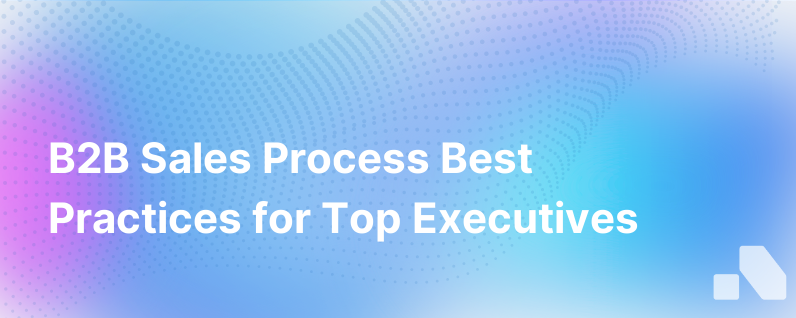B2B Sales Process Best Practices
Published on September 15, 2023 by Sawyer Middeleer
In the contemporary world of B2B sales, the landscape is shifting dramatically due to rapid technological advancements, evolving customer expectations, and increasingly complex solutions. A solid B2B sales process has become more important than ever for businesses to secure, grow, and maintain profitable relationships.
Here’s a comprehensive breakdown of B2B sales process best practices, covering why they're essential, what they involve, and how to implement them effectively to bolster your sales performance.
Why a B2B Sales Process is Crucial:
A B2B sales process provides a framework that standardizes the way sales teams engage with prospects and customers at each stage of their journey. It can result in:
- Increased efficiency and productivity
- Shorter sales cycles
- Higher win rates
- Better forecasting accuracy
- Enhanced customer experiences
The Best Practices:
1. Research and Understand Your Buyer:
Understand who your customers are, what challenges they face, and how they make purchasing decisions. Develop buyer personas through:
- Interviews and surveys with existing customers
- Analysis of customer data for trends and patterns
- Engaging with thought leaders and market analysts
2. Define Clear Sales Stages:
Map out every step of the customer journey from prospecting to close. Define criteria that must be met to move a prospect from one stage to the next and ensure all sales reps adhere to this.
3. Develop a Targeted Value Proposition:
Create a compelling value proposition tailored to each customer segment. This should highlight:
- How your solution addresses unique pain points
- The tangible benefits and outcomes it delivers
- The differentiators that set your offering apart from competitors
4. Utilize a Consultative Sales Approach:
Shift from product-centric selling to a customer-centric, consultative approach. This involves:
- Deep discovery to understand customer needs
- Developing a trusted advisor relationship
- Offering solutions aligned with customer goals
5. Implement Sales Enablement Tools:
Invest in sales enablement technologies that enhance productivity and provide actionable insights. The proper tools can streamline:
- Customer relationship management (CRM)
- Sales automation
- Data analysis and reporting
6. Focus on Sales and Marketing Alignment:
Ensure your sales and marketing teams are in lockstep by:
- Developing joint strategies and goals
- Sharing customer insights and content
- Coordinating messaging across all touchpoints
7. Leverage Social Selling:
Harness the power of social media for research, networking, and engaging prospects through:
- Building a professional brand on platforms like LinkedIn
- Sharing valuable content and thought leadership articles
- Participating in industry conversations and groups
8. Master the Art of the Follow-up:
Follow-ups can make or break a deal. Execute them effectively by:
- Being timely and consistent
- Adding value to each interaction
- Using varied communication methods (email, phone, social, etc.)
Capitalize on the goodwill of satisfied customers to generate new leads by:
- Building a referral program with incentives
- Gathering case studies and testimonials for social proof
10. Analyze and Iterate:
Use a data-driven approach to continuously iterate and improve by:
- Tracking key performance indicators (KPIs)
- Conducting regular pipeline reviews
- Gathering feedback from prospects and customers
Implementing Best Practices:
-
Training and Development: Equip your sales team with the skills required to navigate complex B2B sales cycles. Regular training could cover product knowledge, consultative selling techniques, and understanding buyer psychology.
-
Process Documentation: Document your sales process in a way that's easily accessible to your team. Clear guidelines facilitate consistent execution.
-
Sales Coaching: Pair less experienced reps with veterans for on-the-job mentorship. Regular coaching ensures that best practices are upheld.
-
CRM Optimization: A CRM system is a treasure trove for managing sales processes. Optimize it for workflow automation, data analysis, and centralized information sharing.
-
Measurement and Feedback Loop: Establish mechanisms to measure performance against the structured sales process and encourage feedback from team members to refine strategies.
-
Cross-functional Collaboration: Encourage regular meetings between departments that inform the sales process, including marketing, product, and customer service, to align on objectives and share insights.
The Human Element:
Technology and processes are crucial, but don't overlook the human element. The best B2B sales processes:
- Foster genuine connections between sales reps and prospects
- Prioritize understanding and meeting customer needs
- Build and sustain a customer-centric culture within the sales team
Conclusion:
The trajectory toward a successful and sustainable B2B sales operation is steeped in the continuity of strategy, process, and execution. Despite inherent challenges, adherence to a robust sales methodology can notch a significant competitive advantage.
By weaving together comprehensive buyer knowledge with a structured yet adaptable sales journey, effective tooling, and a culture of relentless improvement, B2B organizations can craft sales processes not only primed for immediate gains but also poised for long-term customer value creation.
Remember, placing the customer’s needs and experiences at the heart of your sales strategy isn’t merely a cliche— it's the cornerstone that can determine the ascendency of your B2B enterprise in the competitive market landscape. By following these best practices, your sales team will harness the robustness necessary to thrive in the continually evolving B2B arena.